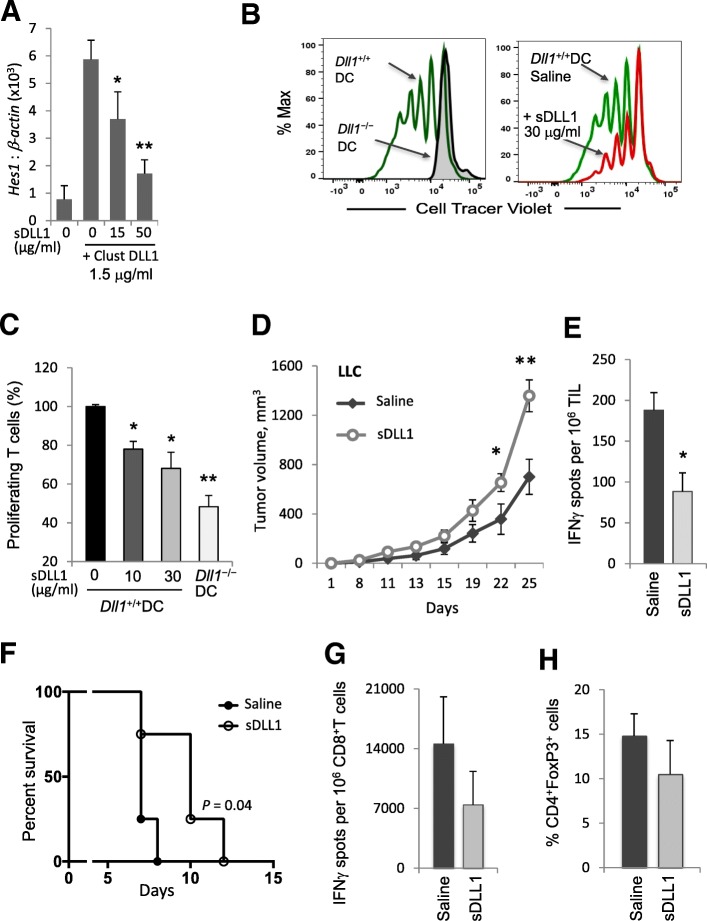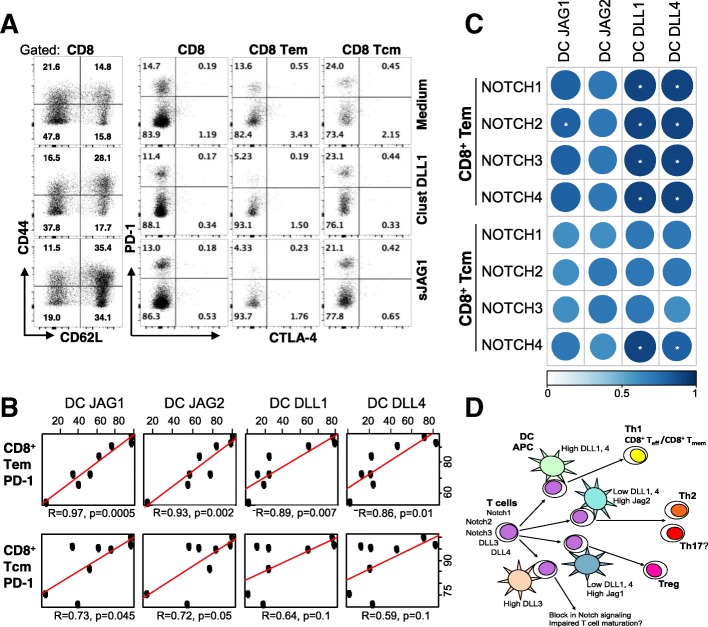Correction to: J Immunother (2019) 7:95
https://doi.org/10.1186/s40425-019-0566-4
Following publication of the original article [1], the author reported the wrong version of Figs. 5 and 7 have been published. The correct version of the figures can be found below:
Fig. 5.
Monomeric soluble DLL1 or Dll1-ablated dendritic cells restrict Notch signaling and impair T-cell cytotoxic responses. a Expression of Notch downstream target Hes1 mRNA was assessed by qRT-PCR in 3 T3 cells treated with clustered DLL1 in the presence of soluble DLL1 (sDLL1) construct at indicated concentrations for 16 h. b, c T-cell proliferation was measured after co-incubating allogeneic T-cells labeled with Cell Tracer Violet fluorescent dye with bone marrow-derived Dll1−/− or wild-type DC in the presence of soluble anti-CD3 for 5 days. In some T-cell cultures with wild-type DC, soluble DLL1 construct was added at the indicated concentrations. Representative Cell Tracer Violet dye dilution profile is shown (b). d Tumor volume was measured in LLC tumor-bearing mice treated with sDLL1 construct 1 mg/kg body weight, i.p. every 2 days for 20 days. e IFN-γ producing tumor-infiltrating cells from these mice were enumerated by ELISPOT assay on day 18 after LLC tumor initiation. Mean ± SEM, 8 mice per group; *, p < 0.05; **, p < 0.005. f, g C57BL/6 mice were transplanted with BALB/c heart allografts on day 0 and treated with sDLL1 construct (1 mg/kg) i.p. on days − 3, − 1, 1, 3, 5 and 7. f Heart allografted C57BL/6 mice log-rank survival. g IFN-γ ELISPOT assay on recipient CD8+T cells isolated after heart allograft and re-stimulated with mitomycin C-treated donor spleen cells in the presence of recipient C57BL/6 splenocytes. h Percentage of FoxP3+ cells among CD4+ splenocytes after heart allograft. Mean ± SEM, 4–8 mice per group; *, p < 0.05
Fig. 7.
Dendritic cell Jagged expression correlates with PD-1 expression on T-effector-memory cells. a Purified T cells were stimulated in vitro in a T:DC (3:1) stimulation co-culture with allogeneic bone marrow-derived dendritic cells in the presence of CD3/CD28 beads (1 μg/mL) for four days with or without treatment with clustered DLL1 (1.5 μg/mL) or monovalent soluble JAG1 (20 μg/mL) constructs. Expression of CD62L, CD44, CTLA-4 and PD-1 was assessed on gated populations as indicated by flow cytometry. Dot plots from a representative experiment out of two independent experiments with duplicates are shown. b-c Lung tumor single cell suspensions from 10 patients were evaluated for the expression of NOTCH ligands on tissue-resident CD11b+CD11chigh dendritic cells and PD-1 and NOTCH receptors in populations of T cells by flow cytometry. NOTCH ligands in CD11b+CD11chigh cells were compared to PD-1 positivity of Tem and Tcm cells (b) or to NOTCH receptor positive T cell subsets by Pearson’s correlation (c). All p-values were corrected using the Benjamani- Hochberg procedure; n = 8; * p < 0.05. Color code indicates the strength of correlation. d Scheme summarizing available data on the regulation of T cell responses by Notch ligands
The original article has been corrected as well.
Contributor Information
Anil Shanker, Email: ashanker@mmc.edu.
Mikhail M. Dikov, Email: Mikhail.Dikov@OSUMC.edu
Reference
- 1.Tchekneva, et al. J ImmunoTherapy Cancer. 2019;7:95. doi: 10.1186/s40425-019-0566-4. [DOI] [PMC free article] [PubMed] [Google Scholar]




